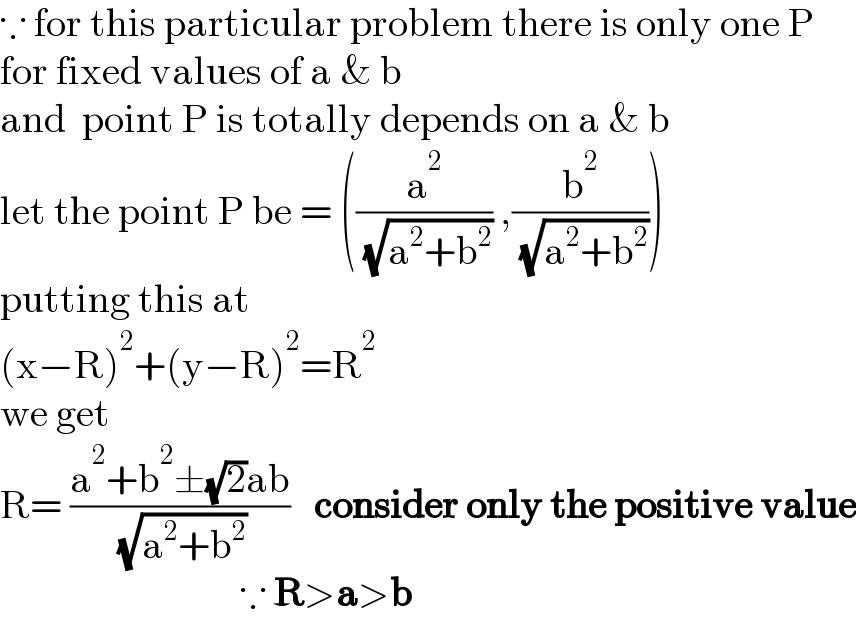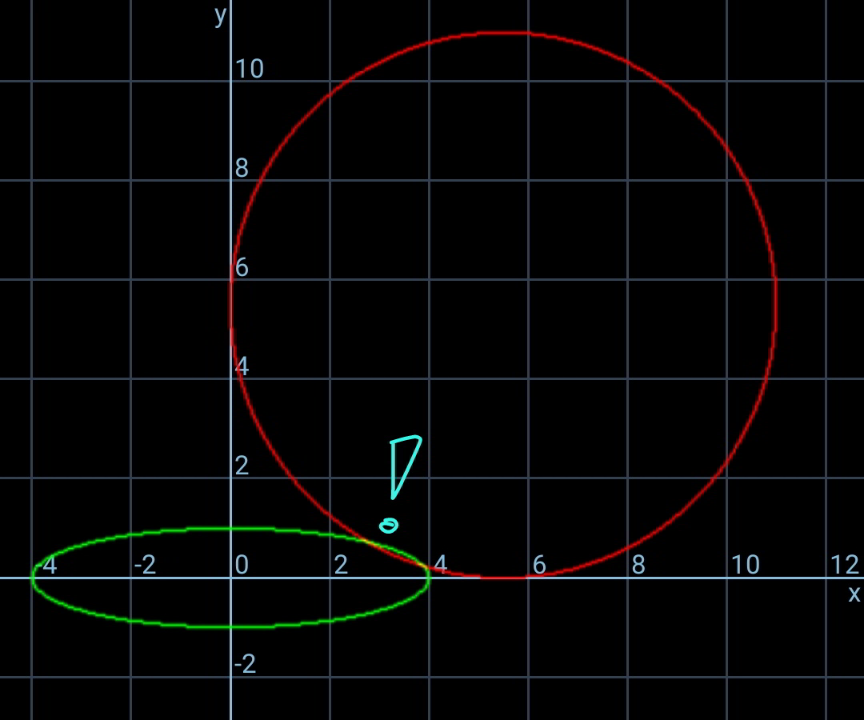
Question Number 127127 by mr W last updated on 27/Dec/20

Commented by mr W last updated on 27/Dec/20

$${This}\:{question}\:{was}\:{once}\:{asked}. \\ $$$$ \\ $$$${Find}\:{the}\:{radius}\:{of}\:{circle}\:{in}\:{terms}\:{of} \\ $$$${parameters}\:{a}\:{and}\:{b}\:{of}\:{the}\:{ellipse}. \\ $$
Commented by PRITHWISH SEN 2 last updated on 27/Dec/20

$$\mathrm{I}\:\mathrm{found}\:\mathrm{it}\:.\:\mathrm{Didn}'\mathrm{t}\:\mathrm{know}\:\mathrm{it}\:\mathrm{is}\:\mathrm{correct}\:\mathrm{or}\:\mathrm{not}\:. \\ $$$$\mathrm{R}^{\mathrm{2}} \left(\mathrm{a}^{\mathrm{2}} +\mathrm{2a}^{\mathrm{2}} \mathrm{be}\sqrt{\mathrm{a}^{\mathrm{2}} −\mathrm{2b}^{\mathrm{2}} +\mathrm{1}}\:\right)−\mathrm{2Rae}\left(\mathrm{a}^{\mathrm{3}} \sqrt{\mathrm{1}+\mathrm{b}^{\mathrm{2}} }\:+\:\mathrm{b}^{\mathrm{3}} \sqrt{\mathrm{a}^{\mathrm{2}} −\mathrm{2b}^{\mathrm{2}} −\mathrm{1}}\:\right)+\left(\mathrm{a}^{\mathrm{4}} +\mathrm{a}^{\mathrm{4}} \mathrm{b}^{\mathrm{2}} +\mathrm{a}^{\mathrm{2}} \mathrm{b}^{\mathrm{4}} −\mathrm{2b}^{\mathrm{6}} −\mathrm{b}^{\mathrm{4}} \right)=\mathrm{0} \\ $$$$\mathrm{please}\:\mathrm{check}\:\mathrm{it}\:\mathrm{sir}. \\ $$
Commented by mr W last updated on 27/Dec/20

$${what}\:{is}\:{e}\:{in}\:{your}\:{equation}? \\ $$$${i}\:{can}'{t}\:{check}\:{your}\:{solution}.\:{please} \\ $$$${show}\:{your}\:{working}\:{sir}! \\ $$$${i}\:{didn}'{t}\:{think}\:{it}\:{is}\:{possible}\:{to}\:{get}\:{a} \\ $$$${quadratic}\:{equation}\:{for}\:{R},\:{but}\:{it}'{s} \\ $$$${great}\:{when}\:{you}\:{have}\:{found}\:{a}\:{way}. \\ $$
Commented by PRITHWISH SEN 2 last updated on 27/Dec/20

$$\mathrm{ok}\:\mathrm{sir}\:\mathrm{i}\:\mathrm{will}\:\mathrm{post}\:\mathrm{it}\:\mathrm{later}.\mathrm{e}\:\mathrm{is}\:\mathrm{ecentricity}. \\ $$
Commented by ajfour last updated on 27/Dec/20

Commented by ajfour last updated on 30/Dec/20
![A Point of ellipse (acos ψ,bsin ψ) let s is distance of this point from center of circle. s^2 =(R−acos ψ)^2 +(R−bsin ψ)^2 s_(min) =R ...(i) s^2 =2R^2 +a^2 cos^2 ψ+b^2 sin^2 ψ −2R(bsin ψ+acos ψ) ...(ii) (ds^2 /dψ)=(b^2 −a^2 )sin 2ψ−2R(bcos ψ−asin ψ) (ds^2 /dψ)=0 ⇒ (b^2 −a^2 )=R((b/(sin ψ))−(a/(cos ψ))) ...(iii) from (i),(ii), (iii)with tan ψ=m R^2 (1+m^2 )=a^2 +b^2 m^2 −2R(bm+a)(√(1+m^2 )) ...(I) and (b^2 −a^2 )m=R(b−a)(√(1+m^2 )) ⇒ (b+a)m=R(√(1+m^2 )) (a≠b) ⇒ (m/( (√(1+m^2 ))))=(R/(b+a)) And (1/(1+m^2 ))=(((b+a)^2 −R^2 )/((b+a)^2 )) substituting for R(m) in (I) (b+a)^2 m^2 =a^2 +b^2 m^2 −2m(b+a)(bm+a) ⇒ a^2 m^2 +2abm^2 = a^2 −2b^2 m^2 −2abm−2abm^2 −2a^2 m (a^2 +4ab+2b^2 )m^2 +2a(a+b)m−a^2 =0 m=((−a(a+b))/((a+b)^2 +2b(a+b))) +(√((a^2 (a+b)^2 +a^2 (a+b)^2 +2a^2 b(a+b))/([(a+b)^2 +2b(a+b)]^2 ))) now (m/( (√(1+m^2 ))))=(R/(b+a)) ⇒ R=((m(a+b))/( (√(1+m^2 ))))](Q127465.png)
$${A}\:{Point}\:{of}\:{ellipse}\:\left({a}\mathrm{cos}\:\psi,{b}\mathrm{sin}\:\psi\right) \\ $$$${let}\:{s}\:{is}\:{distance}\:{of}\:{this}\:{point}\:\: \\ $$$${from}\:{center}\:{of}\:{circle}. \\ $$$${s}^{\mathrm{2}} =\left({R}−{a}\mathrm{cos}\:\psi\right)^{\mathrm{2}} +\left({R}−{b}\mathrm{sin}\:\psi\right)^{\mathrm{2}} \\ $$$${s}_{{min}} ={R}\:\:\:\:...\left({i}\right) \\ $$$${s}^{\mathrm{2}} =\mathrm{2}{R}^{\mathrm{2}} +{a}^{\mathrm{2}} \mathrm{cos}\:^{\mathrm{2}} \psi+{b}^{\mathrm{2}} \mathrm{sin}\:^{\mathrm{2}} \psi \\ $$$$\:\:\:\:\:\:\:−\mathrm{2}{R}\left({b}\mathrm{sin}\:\psi+{a}\mathrm{cos}\:\psi\right)\:\:...\left({ii}\right) \\ $$$$\frac{{ds}^{\mathrm{2}} }{{d}\psi}=\left({b}^{\mathrm{2}} −{a}^{\mathrm{2}} \right)\mathrm{sin}\:\mathrm{2}\psi−\mathrm{2}{R}\left({b}\mathrm{cos}\:\psi−{a}\mathrm{sin}\:\psi\right) \\ $$$$\frac{{ds}^{\mathrm{2}} }{{d}\psi}=\mathrm{0}\:\:\:\Rightarrow \\ $$$$\left({b}^{\mathrm{2}} −{a}^{\mathrm{2}} \right)={R}\left(\frac{{b}}{\mathrm{sin}\:\psi}−\frac{{a}}{\mathrm{cos}\:\psi}\right)\:\:...\left({iii}\right) \\ $$$${from}\:\left({i}\right),\left({ii}\right),\:\left({iii}\right){with}\:\mathrm{tan}\:\psi={m} \\ $$$${R}^{\mathrm{2}} \left(\mathrm{1}+{m}^{\mathrm{2}} \right)={a}^{\mathrm{2}} +{b}^{\mathrm{2}} {m}^{\mathrm{2}} \\ $$$$\:\:\:\:\:\:\:\:\:\:\:−\mathrm{2}{R}\left({bm}+{a}\right)\sqrt{\mathrm{1}+{m}^{\mathrm{2}} }\:\:...\left({I}\right) \\ $$$${and}\:\:\left({b}^{\mathrm{2}} −{a}^{\mathrm{2}} \right){m}={R}\left({b}−{a}\right)\sqrt{\mathrm{1}+{m}^{\mathrm{2}} } \\ $$$$\Rightarrow\:\:\left({b}+{a}\right){m}={R}\sqrt{\mathrm{1}+{m}^{\mathrm{2}} }\:\:\left({a}\neq{b}\right) \\ $$$$\Rightarrow\:\:\frac{{m}}{\:\sqrt{\mathrm{1}+{m}^{\mathrm{2}} }}=\frac{{R}}{{b}+{a}} \\ $$$${And}\:\:\:\:\frac{\mathrm{1}}{\mathrm{1}+{m}^{\mathrm{2}} }=\frac{\left({b}+{a}\right)^{\mathrm{2}} −{R}^{\mathrm{2}} }{\left({b}+{a}\right)^{\mathrm{2}} } \\ $$$${substituting}\:{for}\:{R}\left({m}\right)\:{in}\:\left({I}\right) \\ $$$$\:\left({b}+{a}\right)^{\mathrm{2}} {m}^{\mathrm{2}} ={a}^{\mathrm{2}} +{b}^{\mathrm{2}} {m}^{\mathrm{2}} \\ $$$$\:\:\:\:\:\:\:\:\:\:\:\:\:\:\:\:\:\:\:\:\:\:\:\:\:\:\:\:−\mathrm{2}{m}\left({b}+{a}\right)\left({bm}+{a}\right) \\ $$$$\Rightarrow\:{a}^{\mathrm{2}} {m}^{\mathrm{2}} +\mathrm{2}{abm}^{\mathrm{2}} \\ $$$$\:\:\:=\:{a}^{\mathrm{2}} −\mathrm{2}{b}^{\mathrm{2}} {m}^{\mathrm{2}} −\mathrm{2}{abm}−\mathrm{2}{abm}^{\mathrm{2}} \\ $$$$\:\:\:\:\:\:\:\:\:\:\:−\mathrm{2}{a}^{\mathrm{2}} {m} \\ $$$$\left({a}^{\mathrm{2}} +\mathrm{4}{ab}+\mathrm{2}{b}^{\mathrm{2}} \right){m}^{\mathrm{2}} +\mathrm{2}{a}\left({a}+{b}\right){m}−{a}^{\mathrm{2}} =\mathrm{0} \\ $$$${m}=\frac{−{a}\left({a}+{b}\right)}{\left({a}+{b}\right)^{\mathrm{2}} +\mathrm{2}{b}\left({a}+{b}\right)} \\ $$$$\:+\sqrt{\frac{{a}^{\mathrm{2}} \left({a}+{b}\right)^{\mathrm{2}} +{a}^{\mathrm{2}} \left({a}+{b}\right)^{\mathrm{2}} +\mathrm{2}{a}^{\mathrm{2}} {b}\left({a}+{b}\right)}{\left[\left({a}+{b}\right)^{\mathrm{2}} +\mathrm{2}{b}\left({a}+{b}\right)\right]^{\mathrm{2}} }} \\ $$$${now}\:\:\frac{{m}}{\:\sqrt{\mathrm{1}+{m}^{\mathrm{2}} }}=\frac{{R}}{{b}+{a}} \\ $$$$\Rightarrow\:\:{R}=\frac{{m}\left({a}+{b}\right)}{\:\sqrt{\mathrm{1}+{m}^{\mathrm{2}} }}\:\: \\ $$
Commented by PRITHWISH SEN 2 last updated on 28/Dec/20

$$\mathrm{circle} \\ $$$$\left(\mathrm{x}−\mathrm{R}\right)^{\mathrm{2}} +\left(\mathrm{y}−\mathrm{R}\right)^{\mathrm{2}} =\mathrm{R}^{\mathrm{2}} \\ $$$$\mathrm{now}\:\mathrm{P}\equiv\:\left(\mathrm{acos}\:\theta,\mathrm{bsin}\:\theta\right) \\ $$$$\therefore\:\mathrm{R}−\mathrm{x}=\mathrm{Rcos}\:\theta\:\:\:\left(\because\:\mathrm{x}<\mathrm{R}\right)\Rightarrow\boldsymbol{\mathrm{x}}=\:\mathrm{R}\left(\mathrm{1}−\mathrm{cos}\:\theta\right) \\ $$$$\:\&\:\mathrm{R}−\mathrm{y}=\:\mathrm{Rsin}\:\theta\:\left(\because\mathrm{y}<\mathrm{R}\right)\Rightarrow\boldsymbol{\mathrm{y}}\:=\:\mathrm{R}\left(\mathrm{1}−\mathrm{sin}\:\theta\right) \\ $$$$\therefore\mathrm{R}\left(\mathrm{1}−\mathrm{cos}\:\theta\right)=\mathrm{acos}\:\theta\:\Rightarrow\:\mathrm{cos}\:\boldsymbol{\theta}=\:\frac{\mathrm{R}}{\mathrm{a}+\mathrm{R}} \\ $$$$\mathrm{similarly}\:\mathrm{sin}\:\theta\:=\:\frac{\mathrm{R}}{\mathrm{b}+\mathrm{R}} \\ $$$$\mathrm{from}\:\mathrm{ellipse} \\ $$$$\frac{\mathrm{1}}{\left(\mathrm{a}+\mathrm{R}\right)^{\mathrm{2}} }\:+\:\frac{\mathrm{1}}{\left(\mathrm{b}+\mathrm{R}\right)^{\mathrm{2}} }\:=\frac{\mathrm{1}}{\mathrm{R}^{\mathrm{2}} }\:\:\left\{\frac{\mathrm{x}^{\mathrm{2}} }{\mathrm{a}^{\mathrm{2}} }+\frac{\mathrm{y}^{\mathrm{2}} }{\mathrm{b}^{\mathrm{2}} }=\mathrm{1},\:\mathrm{where}\:\mathrm{x}=\mathrm{acos}\:\theta,\mathrm{y}=\mathrm{bsin}\:\theta\right\} \\ $$$$\mathrm{please}\:\mathrm{check} \\ $$$$ \\ $$
Commented by PRITHWISH SEN 2 last updated on 28/Dec/20

$$\mathrm{another}\:\mathrm{way} \\ $$$$\mathrm{R}=\:\frac{\mathrm{a}^{\mathrm{2}} +\mathrm{b}^{\mathrm{2}} +\sqrt{\mathrm{2}}\mathrm{ab}}{\:\sqrt{\mathrm{a}^{\mathrm{2}} +\mathrm{b}^{\mathrm{2}} }} \\ $$$$\mathrm{if}\:\mathrm{a}=\mathrm{4}\:\mathrm{b}=\mathrm{3}\:\mathrm{then}\:\mathrm{R}=\mathrm{8}.\mathrm{39} \\ $$
Commented by PRITHWISH SEN 2 last updated on 28/Dec/20

Commented by PRITHWISH SEN 2 last updated on 28/Dec/20

$$\because\:\mathrm{for}\:\mathrm{this}\:\mathrm{particular}\:\mathrm{problem}\:\mathrm{there}\:\mathrm{is}\:\mathrm{only}\:\mathrm{one}\:\mathrm{P} \\ $$$$\mathrm{for}\:\mathrm{fixed}\:\mathrm{values}\:\mathrm{of}\:\mathrm{a}\:\&\:\mathrm{b} \\ $$$$\mathrm{and}\:\:\mathrm{point}\:\mathrm{P}\:\mathrm{is}\:\mathrm{totally}\:\mathrm{depends}\:\mathrm{on}\:\mathrm{a}\:\&\:\mathrm{b} \\ $$$$\mathrm{let}\:\mathrm{the}\:\mathrm{point}\:\mathrm{P}\:\mathrm{be}\:=\:\left(\frac{\mathrm{a}^{\mathrm{2}} }{\:\sqrt{\mathrm{a}^{\mathrm{2}} +\mathrm{b}^{\mathrm{2}} }}\:,\frac{\mathrm{b}^{\mathrm{2}} }{\:\sqrt{\mathrm{a}^{\mathrm{2}} +\mathrm{b}^{\mathrm{2}} }}\right) \\ $$$$\mathrm{putting}\:\mathrm{this}\:\mathrm{at} \\ $$$$\left(\mathrm{x}−\mathrm{R}\right)^{\mathrm{2}} +\left(\mathrm{y}−\mathrm{R}\right)^{\mathrm{2}} =\mathrm{R}^{\mathrm{2}} \\ $$$$\mathrm{we}\:\mathrm{get} \\ $$$$\mathrm{R}=\:\frac{\mathrm{a}^{\mathrm{2}} +\mathrm{b}^{\mathrm{2}} \pm\sqrt{\mathrm{2}}\mathrm{ab}}{\:\sqrt{\mathrm{a}^{\mathrm{2}} +\mathrm{b}^{\mathrm{2}} }}\:\:\:\boldsymbol{\mathrm{consider}}\:\boldsymbol{\mathrm{only}}\:\boldsymbol{\mathrm{the}}\:\boldsymbol{\mathrm{positive}}\:\boldsymbol{\mathrm{value}} \\ $$$$\:\:\:\:\:\:\:\:\:\:\:\:\:\:\:\:\:\:\:\:\:\:\:\:\:\:\:\:\:\:\because\:\boldsymbol{\mathrm{R}}>\boldsymbol{\mathrm{a}}>\boldsymbol{\mathrm{b}} \\ $$
Commented by ajfour last updated on 28/Dec/20

$${Great}! \\ $$
Commented by mr W last updated on 28/Dec/20

$${thanks}\:{for}\:{showing}\:{your}\:{working} \\ $$$${sir}\:{Prithwish}! \\ $$$${but}\:{this}\:{easy}\:{looking}\:{solution}\:{is}\:{in} \\ $$$${fact}\:{not}\:{correct}. \\ $$$${the}\:{error}\:{lies}\:{in}\:{following}\:{step}: \\ $$$$\mathrm{P}\equiv\:\left(\mathrm{acos}\:\boldsymbol{\theta},\mathrm{bsin}\:\boldsymbol{\theta}\right)\:\checkmark \\ $$$$\therefore\:\mathrm{R}−\mathrm{x}\neq\mathrm{Rcos}\:\theta\:\:\left({only}\:{true}\:{if}\:{ellipse}\:{is}\:{circle}\right) \\ $$$$\:\&\:\mathrm{R}−\mathrm{y}\neq\:\mathrm{Rsin}\:\theta\:\:\left({only}\:{true}\:{if}\:{ellipse}\:{is}\:{circle}\right) \\ $$$$ \\ $$$${correct}\:{is}: \\ $$$${R}−{x}={R}\:\mathrm{cos}\:\varphi \\ $$$${R}−{y}={R}\:\mathrm{sin}\:\varphi \\ $$$${with}\:\varphi\:\neq\boldsymbol{\theta} \\ $$$$\left(\varphi=\theta\:{only}\:{if}\:{the}\:{ellipse}\:{is}\:{a}\:{circle}\right) \\ $$$$ \\ $$$${you}\:{have}\:{graphed}\:{an}\:{example}\:{with} \\ $$$${a}=\mathrm{4},\:{b}=\mathrm{3}\:{which}\:{is}\:{nearly}\:{a}\:{circle}, \\ $$$${therefore}\:{the}\:{graph}\:{seems}\:{to}\:{be}\:{ok}, \\ $$$${but}\:{in}\:{fact}\:{the}\:{graph}\:{is}\:{wrong},\:{because} \\ $$$${the}\:{big}\:{circle}\:{doesn}'{t}\:{tangent}\:{the} \\ $$$${ellipse}\:{really},\:{but}\:{just}\:{intersects}\:{it}. \\ $$$$ \\ $$$${if}\:{you}\:{take}\:{an}\:{example}\:{like} \\ $$$${a}=\mathrm{4},\:{b}=\mathrm{1}\:{which}\:{is}\:{clearly}\:{not}\:{near} \\ $$$${a}\:{circle},\:{then}\:{you}'{ll}\:{see}\:{that}\:{the}\:{graph} \\ $$$${is}\:{clearly}\:{not}\:{correct}: \\ $$
Commented by mr W last updated on 28/Dec/20

Commented by ajfour last updated on 30/Dec/20

$${Sir}\:\:\psi\:\:{is}\:{variable}\:; \\ $$$$\frac{{ds}^{\mathrm{2}} }{{d}\psi}=\mathrm{0}\:\:\Rightarrow\:\:\psi=\psi_{\mathrm{0}} \:\:;\:\:{s}\left(\psi_{\mathrm{0}} \right)={R}. \\ $$
Commented by ajfour last updated on 28/Dec/20

$$\:\:\:{Else}\:\bigstar \\ $$$$\:\:\:\:\:\frac{{a}}{{b}\mathrm{cos}\:\phi}−\frac{{b}}{{a}\mathrm{sin}\:\phi}\:=\:\frac{{a}}{{b}}−\frac{{b}}{{a}} \\ $$$$\:\:\:\:\frac{{a}^{\mathrm{2}} \mathrm{sin}\:\phi−{b}^{\mathrm{2}} \mathrm{cos}\:\phi}{\mathrm{sin}\:\phi\mathrm{cos}\:\phi}={a}^{\mathrm{2}} −{b}^{\mathrm{2}} \\ $$$${a}^{\mathrm{4}} \mathrm{sin}\:^{\mathrm{2}} \phi=\left(\mathrm{1}−\mathrm{sin}\:^{\mathrm{2}} \phi\right)\left\{\left({a}^{\mathrm{2}} −{b}^{\mathrm{2}} \right)\mathrm{sin}\:\phi+{b}^{\mathrm{2}} \right\}^{\mathrm{2}} \\ $$$${let}\:\:\frac{{b}^{\mathrm{2}} }{{a}^{\mathrm{2}} }={c}\:\:,\:\:\mathrm{sin}\:\phi={t}\:\:\:{then} \\ $$$$\:\:\:\:{t}^{\mathrm{2}} =\left(\mathrm{1}−{t}^{\mathrm{2}} \right)\left\{\left(\mathrm{1}−{c}\right){t}+{c}^{\mathrm{2}} \right\}^{\mathrm{2}} \\ $$$$...... \\ $$
Commented by mr W last updated on 28/Dec/20

$${let}\:\mu=\frac{{b}}{{a}},\:\lambda=\frac{{R}}{{a}} \\ $$$${i}\:{think}\:{we}\:{can}\:{only}\:{express}\:{the} \\ $$$${relationship}\:{between}\:\lambda\:{and}\:\mu\:{via} \\ $$$${a}\:{parameter}\:{such}\:{as}\:\phi: \\ $$$$\begin{cases}{\mu=\sqrt{\frac{\mathrm{sin}\:\phi\left(\mathrm{1}−\mathrm{cos}\:\phi\right)}{\mathrm{cos}\:\phi\left(\mathrm{1}−\mathrm{sin}\:\phi\right)}}}\\{\lambda=\frac{\mathrm{1}}{\:\sqrt{\left(\mathrm{1}−\mathrm{sin}\:\phi\right)^{\mathrm{2}} +\frac{\mathrm{cos}\:\phi\left(\mathrm{1}−\mathrm{cos}\:\phi\right)\left(\mathrm{1}−\mathrm{sin}\:\phi\right)}{\mathrm{sin}\:\phi}}}}\end{cases} \\ $$
Commented by mr W last updated on 28/Dec/20

Commented by mr W last updated on 30/Dec/20

$${example}\:{with}\:{a}=\mathrm{4},\:{b}=\mathrm{1}\:{doesn}'{t}\:{give} \\ $$$${a}\:{correct}\:{answer}\:{using}\:{your}\:{method}. \\ $$
Commented by mr W last updated on 30/Dec/20

$${for}\:{the}\:{same}\:{reason}\:{that}\:\psi\:{is}\:{not}\:{a} \\ $$$${variable}\:{i}\:{don}'{t}\:{think}\:{we}\:{get}\:{the}\: \\ $$$${right}\:{solution}\:{through}\:\frac{{ds}^{\mathrm{2}} }{{d}\psi}=\mathrm{0}. \\ $$$${we}\:{can}\:{easily}\:{check}\:{this}\:{by}\:{drawing} \\ $$$${the}\:{graph}. \\ $$
